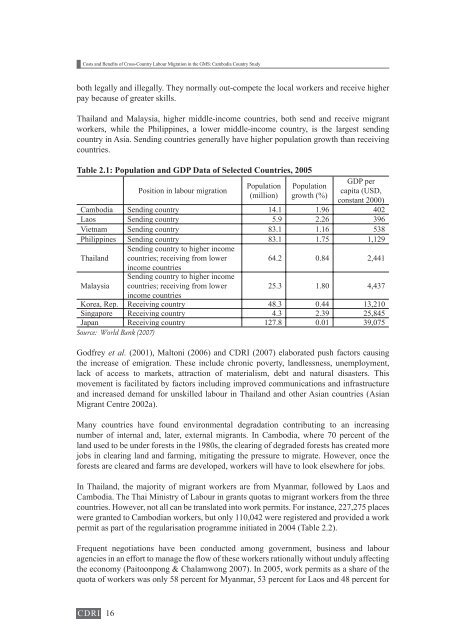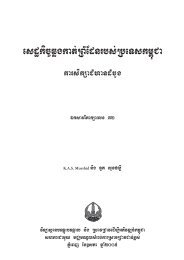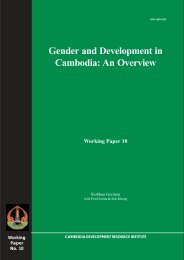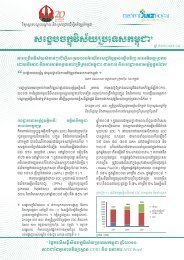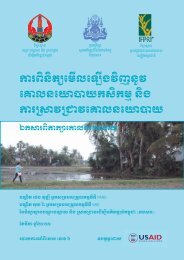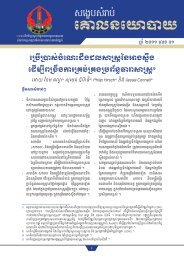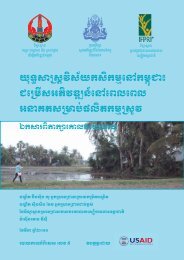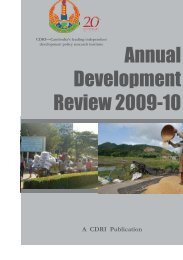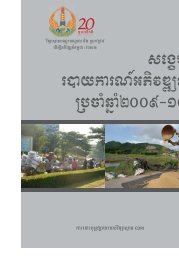Cambodia Country Study Working Paper Series No. 44 ... - CDRI
Cambodia Country Study Working Paper Series No. 44 ... - CDRI
Cambodia Country Study Working Paper Series No. 44 ... - CDRI
You also want an ePaper? Increase the reach of your titles
YUMPU automatically turns print PDFs into web optimized ePapers that Google loves.
��������������������������������������������������������������������������������������<br />
both legally and illegally. They normally out-compete the local workers and receive higher<br />
pay because of greater skills.<br />
��������� ���� ���������� ������� �������������� ����������� ����� ����� ���� �������� ��������<br />
workers, while the Philippines, a lower middle-income country, is the largest sending<br />
country in Asia. Sending countries generally have higher population growth than receiving<br />
countries.<br />
��������������������������������������������������������������<br />
<strong>CDRI</strong><br />
16<br />
Position in labour migration<br />
Population<br />
(million)<br />
Population<br />
growth (%)<br />
GDP per<br />
capita (USD,<br />
constant 2000)<br />
<strong>Cambodia</strong> Sending country 14.1 1.96 402<br />
Laos Sending country 5.9 2.26 396<br />
Vietnam Sending country 83.1 1.16 538<br />
Philippines Sending country<br />
Sending country to higher income<br />
83.1 1.75 1,129<br />
Thailand countries; receiving from lower<br />
income countries<br />
Sending country to higher income<br />
64.2 0.84 2,<strong>44</strong>1<br />
�������� countries; receiving from lower<br />
income countries<br />
25.3 1.80 4,437<br />
Korea, Rep. Receiving country 48.3 0.<strong>44</strong> 13,210<br />
Singapore Receiving country 4.3 2.39 25,845<br />
Japan Receiving country 127.8 0.01 39,075<br />
Source: World Bank (2007)<br />
Godfrey et al.������������������������������������������������������������������������<br />
the increase of emigration. These include chronic poverty, landlessness, unemployment,<br />
lack of access to markets, attraction of materialism, debt and natural disasters. This<br />
movement is facilitated by factors including improved communications and infrastructure<br />
and increased demand for unskilled labour in Thailand and other Asian countries (Asian<br />
�����������������������<br />
����� ���������� ����� ������ �������������� ������������ ������������� ��� ��� �����������<br />
number of internal and, later, external migrants. In <strong>Cambodia</strong>, where 70 percent of the<br />
land used to be under forests in the 1980s, the clearing of degraded forests has created more<br />
�����������������������������������������������������������������������������������������<br />
������������������������������������������������������������������������������������������<br />
������������������������������������������������������������������������������������<br />
�����������������������������������������������������������������������������������������<br />
countries. However, not all can be translated into work permits. For instance, 227,275 places<br />
were granted to <strong>Cambodia</strong>n workers, but only 110,042 were registered and provided a work<br />
permit as part of the regularisation programme initiated in 2004 (Table 2.2).<br />
��������� ������������� ����� ����� ���������� ������ ������������ ��������� ���� �������<br />
���������������������������������������������������������������������������������������������<br />
the economy (Paitoonpong & Chalamwong 2007). In 2005, work permits as a share of the<br />
�����������������������������������������������������������������������������������������


